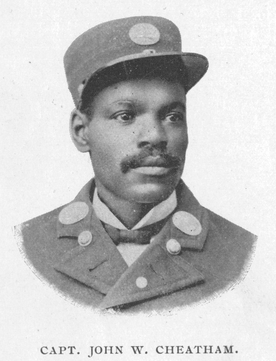John Cheatham facts for kids
Quick facts for kids
John Cheatham
|
|
|---|---|

Portrait of Captain John W. Cheatham
|
|
| Born | 1855 |
| Died | 1918 Minneapolis, Minnesota, United States
|
| Burial place | Minneapolis Pioneers and Soldiers Memorial Cemetery |
| Monuments | Cheatham Avenue |
| Occupation | Firefighter |
| Known for | Racial integration of the Minneapolis Fire Department |
John Cheatham (1855–1918) was a brave American firefighter who lived in Minneapolis, Minnesota, during the late 1800s and early 1900s. He was born into slavery in St. Louis, Missouri. When he was eight years old, he became free because of the Emancipation Proclamation. Soon after, his family moved to Minneapolis.
In 1888, when he was 33, John Cheatham became one of the first Black firefighters in Minneapolis. He held many important leadership jobs during his time with the fire department. In 2022, a street in Minneapolis was renamed Cheatham Avenue to honor him. This was done to remember his important work in helping the city's fire department become more welcoming to people of all races.
Early life
John W. Cheatham was born in 1855. His family was enslaved in the state of Missouri. In 1862, his family became free because of the Emancipation Proclamation. This important document declared many enslaved people free.
Soon after, when John was eight years old, his family moved from St. Louis, Missouri, to Minneapolis, Minnesota. The Cheatham family was one of the first Black families to live in Minneapolis.
Career
Before becoming a firefighter, John Cheatham worked different jobs. He was a sexton at a church, which means he helped take care of the church building. He also worked as a porter, carrying things for people.
In 1888, when he was 33, Cheatham joined the Minneapolis Fire Department. A White fire chief hired him. He was either the first, or one of the very first, Black firefighters in the city.
Cheatham's first job as a firefighter was as a pipeman. This meant he handled the hoses. After three years, he was promoted to a driver. About five years later, he became a lieutenant. In 1899, he was promoted again to the rank of captain. However, he was moved back to being a pipeman a year later. This happened because he refused an order from a White firefighter who had the same rank as him. Cheatham worked at several fire stations in Minneapolis early in his career.
In 1907, Cheatham and two other Black firefighters, Lafayette Mason and Frank Harris, were put in charge of Fire Station 24. This station was on Hiawatha Avenue and 45th Street. It was becoming a station with only Black firefighters. This was a time when many places were segregated, meaning people of different races were kept separate.
Fire Station 24 was in a neighborhood that was mostly White. But it was also near a railroad yard where many Black workers were employed. At first, some White firefighters at Station 24 and some people living nearby did not want Black firefighters assigned there.
Cheatham and the other Black firefighters stood strong. They did not want to be replaced by White firefighters at Station 24. Cheatham famously said he was "drawing the color line and drawing it stiff." This meant he was firmly standing up for Black firefighters. After discussions by city leaders and support from a petition signed by White women in the area, the fire station continued with the Black firefighters. Cheatham worked at this station until he retired in 1911. He had served the fire department for 23 years.
People in the community respected Cheatham during his time as a firefighter. His work was even praised in the Minneapolis Journal newspaper.
Personal life
John Cheatham was married to Susie Cheatham. They owned a home in Minneapolis. John and Susie had four children: Ethel, Bertha, Gilbert, and Wesley. Susie Cheatham passed away in 1906 from typhoid when she was 46. John Cheatham died on August 15, 1918, at the age of 63. He was buried at the Minneapolis Pioneers and Soldiers Memorial Cemetery with other family members.
Legacy
Racial integration
John Cheatham and other Black firefighters at Fire Station 24 were very important. They were the first to help integrate the Minneapolis Fire Department. This means they helped bring people of different races together to work there. From when it opened in 1907 until it closed in 1941, many Black firefighters served at Station 24.
After Station 24 closed, there were no Black firefighters in Minneapolis for 30 years. The city's fire department did not become integrated again until 1972. This happened after a federal judge ordered it.
Cheatham Avenue
After the death of George Floyd in 2020, there were many protests in Minneapolis. People wanted to honor important Black leaders and change names of places that honored people with harmful views.
In 2021, a group of activists asked the City of Minneapolis to rename Dight Avenue. This street had been named after Charles Fremont Dight, who promoted harmful ideas about eugenics. A petition to rename the street gathered many signatures. After talking with people who lived on Dight Avenue, city officials decided to rename it after John Cheatham. The street officially became Cheatham Avenue on March 17, 2022.
Cheatham Avenue is special because most streets in Minneapolis are numbered. This street runs for 10 blocks on the south side of the city. It runs next to Hiawatha Avenue.
See also
- 2020–2021 Minneapolis–Saint Paul racial unrest
- Firefighting in the United States
- History of Minneapolis
- List of name changes due to the George Floyd protests


